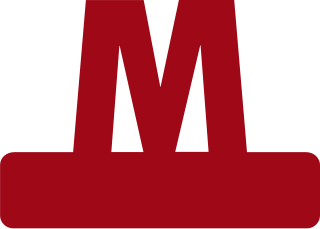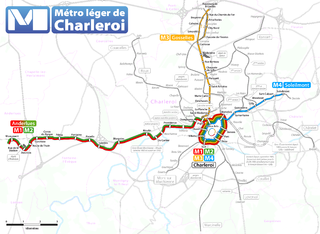
The Copenhagen Metro is a light rapid transit system in Copenhagen, Denmark, serving the municipalities of Copenhagen, Frederiksberg, and Tårnby.

Tennōji Station is a major railway station on the JR West Osaka Loop Line, Hanwa Line, Yamatoji Line, Osaka Metro Midōsuji Line, and Tanimachi Line, located in Tennōji-ku and Abeno-ku, Osaka, Japan, and Tennōji-ekimae Station is a railway station on the tram Hankai Uemachi Line in Abeno-ku, Osaka, Japan. They are also connected to Ōsaka Abenobashi Station on the Kintetsu Minami Osaka Line. It forms as one of Osaka's main railway terminals to the south for lines operated by West Japan Railway Company.

Night service, sometimes also known as owl service, is a mode of public transport service operated during the night hours. As an intermediate approach – between providing full service around the clock and stopping services altogether – it provides more limited service during times of lower passenger volume, saving resources and allowing for maintenance on primary transportation systems. They typically offer fewer routes and less frequent service. Night-based services may be differently branded compared to daytime services. Examples are London and Chicago, where overnight buses are prefixed with an "N" for "night". Another common way to distinguish night services from their daytime counterparts is dark-colored line numbers. Some cities apply a different fare structure for night services from their daytime services.

The Société de transport de Montréal is a public transport agency that operates transit bus and rapid transit services in the urban agglomeration of Montreal, Quebec, Canada. Established in 1861 as the "Montreal City Passenger Railway Company", it has grown to comprise four subway lines with a total of 68 stations, as well as 212 bus routes and 23 night routes. The STM was created in 2002 to replace the Société de transport de la communauté urbaine de Montréal. The STM operates the most heavily used urban mass transit system in Canada, and one of the most heavily used rapid transit systems in North America. As of 2019, the average daily ridership is 2,297,600 passengers: 977,400 by bus, 1,306,500 by rapid transit and 13,700 by paratransit service.

The Rio de Janeiro Metro, commonly referred to as just the Metrô is a rapid transit network that serves the city of Rio de Janeiro, Brazil. The Metrô was inaugurated on 5 March 1979, and consisted of five stations operating on a single line. The system currently covers a total of 58 kilometres (36 mi), serving 41 stations, divided into three lines: Line 1 ; Line 2, which together travel over a shared stretch of line that covers 10 stations of an approximate distance of 5 kilometres (3.1 mi); and Line 4. Metrô Rio has the second highest passenger volume of the metro systems in Brazil, after the São Paulo Metro.

The Brussels tramway network is a tram system serving a large part of the Brussels-Capital Region of Belgium. It is the 16th largest tram system in the world by route length, in 2017 providing 149.1 million journeys over routes 140.6 km (87.4 mi) in length. In 2018, it consisted of 18 tram lines. Brussels trams are operated by STIB/MIVB, the local public transport company.

Public transport in Helsinki consists of bus, tram, metro, local railway and ferry services. The system is managed by the Helsinki Regional Transport Authority and covers Helsinki, Espoo, Kauniainen, Vantaa and the outlying Kerava, Kirkkonummi, Sipoo and Tuusula.

The Prague tramway network is the largest tram network in the Czech Republic, consisting of 144 km (89 mi) of standard gauge (1,435 mm) track, 882 tram vehicles and 26 daytime routes, 2 historical and 10 night routes with a total route length of 518 km (322 mi). It is operated by Dopravní podnik hlavního města Prahy a.s., a company owned by the city of Prague. The network is a part of Prague Integrated Transport, the city's integrated public transport system.

The Métro Léger de Charleroi is a 33-kilometre (21 mi) light rail network in Belgium. The system consists of a loop line around central Charleroi and three branches towards the suburbs of Gilly, Anderlues and Gosselies. Another branch to Châtelet was partially built, never entered service, but will finally do so in 2026.

Gosselies is a town of Wallonia and a district of the municipality of Charleroi, located in the province of Hainaut, Belgium.

Brussels has an extensive network of both private or public transportation means. Public transportation includes Brussels buses, trams, and metro, as well as a set of railway lines and railway stations served by public trains. Air transport is available via one of the city's two airports, and boat transport is available via the Port of Brussels. Bicycle-sharing and car-sharing public systems are also available. The city is relatively car-dependent by northern European standards and is considered to be the most congested city in the world according to the INRIX traffic survey.

Waterloo is a Charleroi Metro station, located at the northern end of Charleroi downtown, in fare zone 1.
Line M1 is a line of the Charleroi Metro in Belgium operated by TEC Charleroi, running from the Monument tram stop in Anderlues to the metro loop around central Charleroi, before heading back to Anderlues. Line M1 was created on 27 February 2012 to replace former lines 88 and 89 after completion of the loop around central Charleroi. Introduction of new line numbers in February 2012 coincided with the formal association of colors to line numbers. The official color for line M1 is red.

Line M2 is a line of the Charleroi Metro in Belgium operated by TEC Charleroi, running from the Monument tram stop in Anderlues to the metro loop around central Charleroi, before heading back to Anderlues. Line M2 was created on 27 February 2012 to replace former lines 88 and 89 after completion of the loop around central Charleroi. Introduction of new line numbers in February 2012 coincided with the formal association of colors to line numbers. The official color for line M2 is green.

Line 4 is a line of the Charleroi Metro in Belgium operated by TEC Charleroi, running from Soleimont in Gilly to the loop around downtown Charleroi, before heading back to Soleilmont.

The term Metrobus is used for special bus services in Germany since 2001. These services operate in Berlin, Munich and Hamburg as well as Braunschweig until 2015. In general, Metrobuses run more frequent than normal bus lines and sometimes also operate at night. They operate via a more straight path than other lines. Nonetheless they are served with normal buses also used on other lines and can be taken with the same ticket.

Local and regional bus services are a large part of public transport in the Helsinki region. HSL bus services include internal services in Helsinki, Espoo, Kauniainen, Vantaa, Kerava, Kirkkonummi, Sipoo, Siuntio and Tuusula and regional services between them.
















